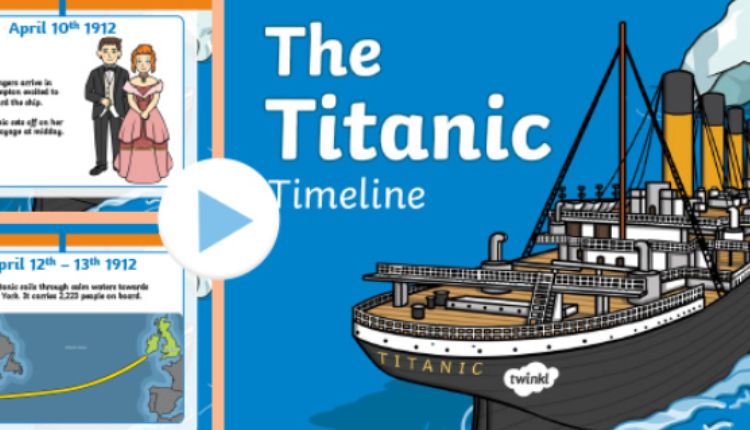This Titanic timeline highlights key events before and after the disaster.
April 14, 1912: Lookouts see an iceberg directly in the path of the ship and send a warning to the bridge. The message does not reach the captain.
Captain Edward J Smith orders lifeboats to be lowered, women and children first. Hundreds of dramas unfold as men see off wives and families, and selfless passengers give up their seats to stay with loved ones.
1. The Launch
RMS Titanic, the world’s largest ship at the time, cruises down Southampton waters on her maiden voyage to North America. Crowds flock to watch. A mere five days later, she will be gone, swallowed up by the Atlantic after striking an iceberg.
On May 31, 1911 titanic timeline immense hull-the single largest movable manmade object ever launched-makes its way down the enormous slipways of Belfast’s Harland & Wolff yard, accompanied by tugs and watched by more than 100,000 people. After a flawless launch the hull is towed to a mammoth fitting-out dock where thousands of workers will spend most of the next year completing her decks and constructing her lavish interiors.
The opulent new liner’s first class accommodations boast squash courts, Turkish baths and the first swimming pool on a ship. Her cheaper third class cabins were also much more spacious than those on other liners. And she carried an impressive array of passenger facilities: a jogging track, gym, barber shop, library and even a pet parrot.
Titanic’s senior wireless operator, Jack Phillips, begins receiving warnings of icebergs from ships further out to sea. At the time, icebergs were uncommon in this area of the Atlantic, but the fact that the ship was sailing into an ice region was significant because it meant the ship would be on a collision course with the berg.
2:20 AM: Captain Edward John Smith orders Titanic to change course. The move should have put the ship into an area of the gulf stream free of icebergs. But in reality, it merely put the ship on an even more hazardous collision course with the iceberg.
2:30 AM: The collision occurs. A huge roar is heard as all of Titanic’s moving objects crash into the bow and the front half of the ship sinks. 3:30 AM: The Carpathia spots rockets from Titanic’s disaster area and speeds to assist.
The last of the collapsible lifeboats are lowered to the water. They are only able to hold about 160 people, less than half the number aboard Titanic at full capacity. At the same time, hundreds of human dramas unfold as men see off wives and children, families are separated in the confusion and selfless passengers give up their places on lifeboats to help others escape.
2. The Voyage
The construction of Titanic, the world’s largest passenger ship, begins at Harland & Wolff’s shipyard in Belfast, Ireland. The keel, the backbone of the ship, is laid down on March 31, 1909. Titanic’s maiden voyage, which will take her to Southampton in England, begins April 10, 1912. Crowds line the streets to watch the massive vessel sail. Many are dressed in white to symbolize eternal life. Titanic is touted as unsinkable because of her numerous watertight compartments and doors.
Senior wireless operator Jack Phillips receives his first iceberg warning from another ship, the Caronia. It warns of icebergs and “growlers,” smaller, harder to see bergs, in an area about a day’s sailing away from the Titanic.
Two hours before midnight, the iceberg strikes Titanic’s starboard bow side. It dents the ship’s hull but does not sink it. The iceberg then brushes along the ship’s sides, disappearing into darkness.
Several passengers assemble on the boat deck. Second Officer Lightoller announces the order that women and children will board lifeboats, while men will go to the stern. He then orders boats lowered. Boat 14 is lowered with 65 female and child survivors and two seamen in charge of the boat. It is later tied to boats 12, 14, collapsible D and other lifeboats.
As Titanic’s bow plunges into the water, a number of second- and third-class passengers jump overboard. The band stops playing. A father hears confession and gives absolution to more than a hundred second-class passengers gathered near the stern of the boat deck.
2:17 AM: Phillips continues to send a final message on the radio. Captain Smith tells crew members that it’s “every man for himself.” He is seen returning to his bridge, possibly to await the end.
The last of the lifeboats is lowered, boat No. 12. Madeleine Astor, five months pregnant and a member of the wealthy Astor family, asks to join the boat. To avoid a rush, Lightoller waves (or possibly fires) his pistol into the air to prevent a crowd from entering the boat. The women and children climb into the boat.
3. The Sinking
Titanic was designed to be the largest and most luxurious ship ever built. It was touted as being unsinkable thanks to a system of watertight compartments and doors. But when the Titanic collided with an iceberg and plunged into the Atlantic on April 15, 1912, all but 705 passengers were lost.
After the collision, the ship’s design was altered to prevent future accidents. Its builders added additional ballast and shifted the weight of cargo to the center of the ship. This reduced the ship’s speed and put less strain on the hull.
At about 11:30 PM, lookouts spotted a large iceberg dead ahead. They sounded a warning bell with three sharp rings and phoned down to the bridge: “Iceberg right ahead.” Captain Edward Smith immediately changes course to a position slightly south of the iceberg’s location in an attempt to avoid it. But the cold gulf stream actually brought him into an area full of icebergs.
The iceberg hits the Titanic at 12:40 AM. Most of the passengers and crew sleep through the impact. Lookout man Fleet suspects the iceberg may have only touched the bow, but the ship is now on a collision course with it. Chief Officer Murdoch orders engines stopped and the helmsman to turn the ship hard to port. Murdoch also activates a lever to close all watertight doors below the waterline.
As the iceberg continues to break up in the water, Titanic’s stern rises and then drops back down again. The stern’s movements cause great stress on the midsection and she breaks in two between the third and fourth funnels. The stern sinks rapidly and disappears from view at 2:17 AM.
The last lifeboats are lowered into the ocean. One of them, boat 14, is tied to boats 4, 10, and collapsible D. Second-class passengers and some crew members swim to the boats. The band stops playing and many people jump overboard. Designer Thomas Andrews is seen in the first-class smoking room, staring at a painting of a ship on the wall. He later deposited his wife Madeline into a boat and kissed her goodbye before he was lowered into the water.
4. Recovery
The Titanic was a gigantic, luxurious ocean liner built by Harland and Wolff in Belfast, Ireland. It was designed to be a symbol of the wealth and power of the White Star line and her maiden voyage was scheduled for April 14, 1912. The unfinished ship was slated to be loaded in Southampton, England, then sail for New York City on its regular transatlantic route.
The newest and largest of the White Star ships, Titanic was a wonder of modern technology and engineering. She was touted as unsinkable – a system of watertight compartments and doors would prevent her from sinking in the event she struck an iceberg or other obstacle in the North Atlantic.
Titanic departed Southampton on its maiden voyage to New York City, stopping in Cherbourg, France and Queenstown (now Cobh), Ireland, on the outbound leg of the trip. The Titanic was carrying 1,317 passengers and a crew of more than 2,200. A who’s who of early 20th century tycoons, socialites, and movie stars were aboard.
At 11:40 p.m., lookout Frederick Fleet spotted an iceberg directly ahead. First Officer Murdoch ordered a hard starboard turn but the ship scrapes the side of the berg. Most passengers and crew slept through the collision, assuming that the ship had survived a glancing blow. In fact, only 37 seconds passed from the moment that Fleet saw the iceberg until the ship collided with it.
After the collision, water entered several compartments and the bow sank beneath the surface. Captain Smith learned that the Titanic could stay afloat for only two hours, so he gave orders to start loading lifeboats, women and children first.
By 12:10 a.m., the Titanic was listing at a 45-degree angle and the water was up to the first deck.
The surviving passengers and crew began to evacuate the lifeboats. Madeleine Astor, five months pregnant, asked to be allowed onto the boat, but Second Officer Lightoller, following strict rules of procedure, refused her request. He also refused to allow Astor’s husband, John Jacob Astor, to join her, citing the order of women and children first.
Conclusion
The Titanic’s tragic maiden voyage in 1912 remains an indelible moment in history, highlighting the consequences of human error and the perils of overconfidence. The loss of over 1,500 lives serves as a stark reminder of the importance of maritime safety measures, shaping modern regulations and fostering a legacy of remembrance.
FAQs:
- Was the Titanic the largest ship of its time? Yes, during its maiden voyage in 1912, the Titanic was one of the largest and most luxurious ships ever built. It was considered a marvel of engineering and opulence, measuring around 882 feet in length.
What caused the sinking of the Titanic? The Titanic struck an iceberg on the night of April 14, 1912, which caused severe damage to its hull. The ship was not equipped with enough lifeboats for all passengers, and this, coupled with communication issues and inadequate evacuation procedures, led to the loss of numerous lives

